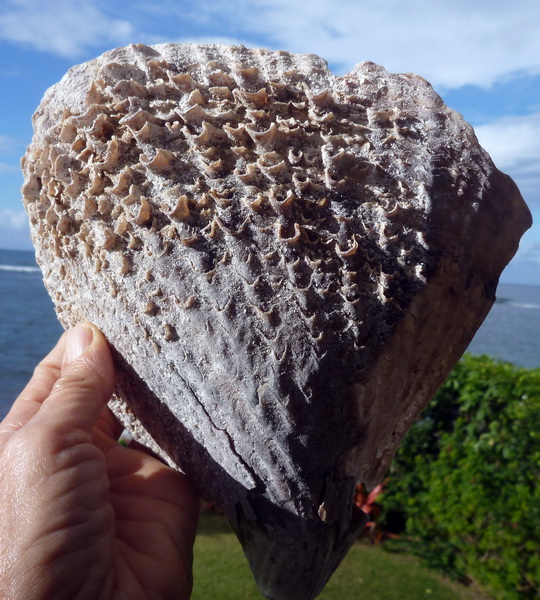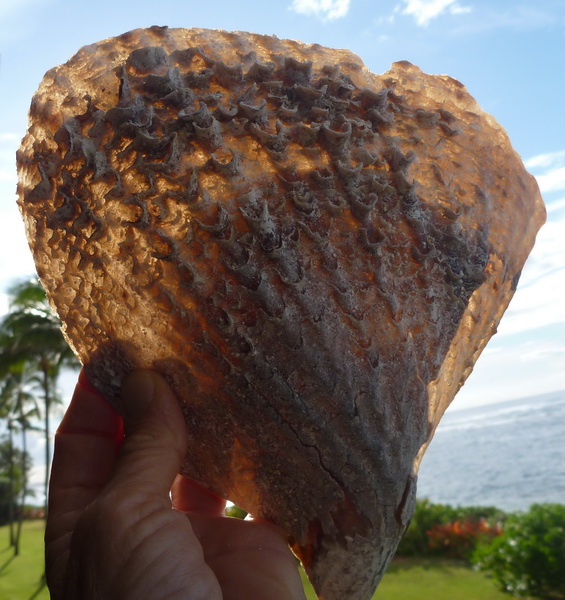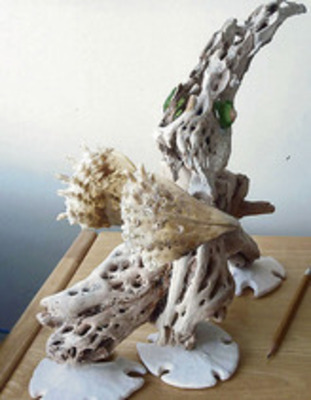Published in the Ocean Watch column, Honolulu Star-Advertiser © Susan Scott
May 9, 2011
I found several hand-size shells on a Baja beach last winter, and learned they’re called pen shells. I would have named the translucent beauties fan shells, since they look like fluted fans decorated with pearly projections outside and lustrous mother-of-pearl inside.
 ©2011 Susan Scott
©2011 Susan Scott
Large Pen Shell
Nineteenth-century Mediterranean fishermen had their own descriptive name for these stunning, mussel-like mollusks: sea wings.
The wide part of the pen shell is the business end of these bivalves. The animals live buried in sand or sediment up to their lips on the ocean floor, filtering water through their gills to trap drifting food particles.
Pen shells are neighborly, sometimes hosting small shrimp or crabs inside their always open shells. Dense pen colonies also provide a lumpy sea-floor habitat for other marine animals.
Conchs and tritons come visiting, too, but these are no social calls. The predator snails attack and eat the immobile, half-buried pens.

In learning more about pen shells, I came to admire their pointy end, too, the “pen” of pen shells. Near the tip is a gland that secretes byssus, a protein compound forming strands called byssal threads.
Countless bivalves make byssal threads to anchor themselves in place, attaching the fibers to rock, rubble and sometimes each other.
Humans found an odd use for these tough filaments: designer clothes. In the ancient Mediterranean, people collected the 14-inch-long giant Mediterranean pen shells, also called thread shells, for their meat (which supposedly tastes like scallops) and also for their byssal threads, which were woven into fabric. The result was known as cloth of gold, golden fleece and sea silk.
So fine was this olive-gold material that a pair of gloves made of it supposedly could be folded into a walnut shell.
The huge number of pen shells one garment required, and the amount of time it took for people to collect, clean, spin, weave and sew the piece, caused cloth of gold apparel to be extraordinarily expensive. Only the very rich, which included royalty and popes, could afford robes of sea silk.
Today Mediterranean giant pen shells are an endangered species due to overfishing, poaching and water degradation.
Hawaii hosts four pen shell species. Two are naturally rare here, and another has been decimated by storms. Because pen shells can’t close their two shells tightly, they are vulnerable to smothering during underwater sandstorms.
Kona storms in 1980 killed countless pen shells living in large colonies off Maui and the Waianae Coast. Hurricane Iwa struck another blow in 1982, killing what was left of the colonies. The creatures have not recovered.
Our fourth pen shell species is the only one with a Hawaiian name: nahawele. This species, also called the baggy pen shell, is fairly common in the main islands but is hard to see. The bivalve lives from 3 to 50 feet deep in sand around large boulders, and also tucked into crevices.
I so admired the Baja pen shells I found, I brought two home with me and used them in a decoration I made for my desk. For me it’s the perfect pen pal.
